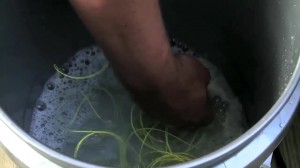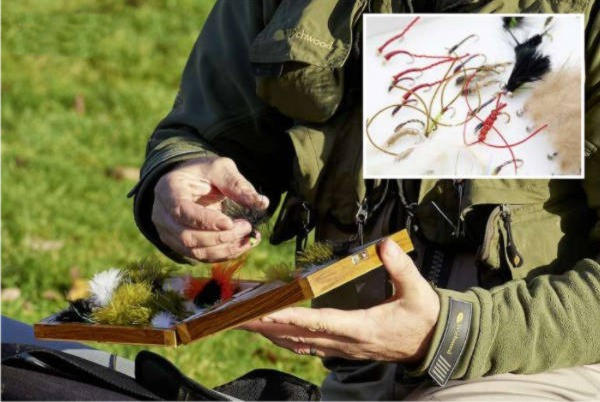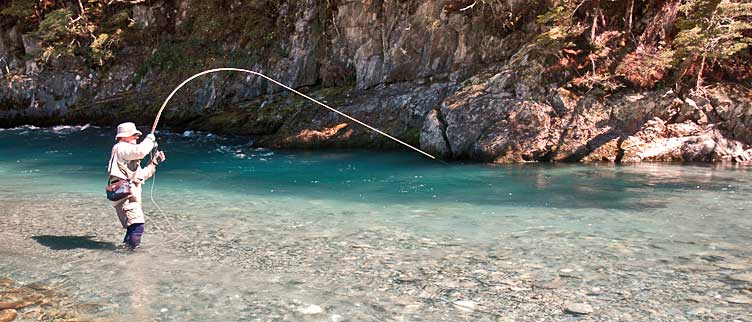| Disclosure: Just to be open and honest the buttons and links you click on in the website will in most cases take you to another website where you can purchase the products I am reviewing. As an Amazon Associate I earn from qualifying purchases. |
New Trout Fishing Season – Getting Prepared
Well, winter is now over and its time to get the tackle out from its winter hibernation for a good cleaning in preparation for the new trout fishing season.
There are a few things that should be done each spring to ensure you tackle is on tip top condition before going out on your first fishing trip.
- Check fly lines for cracks
- Clean reel and apply lubrication
- Wax rod furrels
- Re-new knots for the line connections
- Check rods for any cracks or chips.
- Inspect cork handle
- Check waders for leaks
- Check fly selection
- Inspect leader material
- Renew all licenses and permits
These are some of the main items that need sorting before a new season begins. Of these, I would suggest checking the fly line and rod as the most important.
Quick Post Navigation
Checking the fly line for cracks
When you put away your gear at the end of the previous season you would have probably left one or two fly lines still on their reels.
Depending on the place or storage there will no doubt be some coil memory left on the line from being stored so long in that position.
My suggestion to you before going to fish is you unspool the line onto a bucket of soapy water then after about half an hour soak slowly pull the line through a soft cloth squeezed in your other hand.
While doing this check for any cracks or chips along the line and assess them for integrity.
If there are a lot then it would be better to purchase a new line than risk losing some trout to breakages.
Working this process you will take any grime or dirt away as well as slowly get the line straight.
Here is a couple of RIO products videos on how to do that and apply a dressing to the fly line to keep it fishing well for years.
Some branded lines are better at keeping their intended shape than other budget lines so it will depend on how many times you need to do this to really get it straight.
I would be careful not to pull at it too hard for fear of damaging it, a gentle squeeze is all that is required.
If you are still having problems tying one end to a fence pole and walking away stretching the whole line out can usually do the trick.
If the line is really dirty then Gherke’s Line Cleaner can really get into the pores and do that for you.
Clean reel and apply lubrication
Like any piece of machinery having it serviced and lubricated will keep it working for longer.
A fly reel is no different, the reel spins thousands of times each session and to keep it spinning it’s a good idea to have the innards cleaned out and lubricated.
Some reels have sealed disc braking systems in which case that will have to stay intact.
However, you can still clean around the spindle and make sure there are no cracks or dents. A drop of reel lubrication oil on the spindle will help keep these running too.
Other reels can be taken apart down to their single parts cleaned and put back together to keep everything running smoothly.
If like me you have a number of reels the time can mount up in servicing them all but most tackle huts will provide the service at a small cost.
It could be the difference to you landing that personal best or not.
Waxing the rod ferrules! Helps them from slipping
Another important part of gear maintenance is waxing the rod ferrules.
The ferrule is where the rod sections join with one inserting into another.
These can become smooth over time with building breaking the rod for each outing and when this happens it is quite likely that they will come apart during casting.
If this happens the top section will either come away altogether or slightly and if the latter happens and you hook a fish there is a good chance the rod will break.
So to avoid both of these scenarios you need to wax the ferrules regularly so they stay tight during a fishing session.
As a rule, I would always check the ferrules every half hour or so when fishing just to be sure but treating them with wax can make a big difference and they will usually stay intact for a whole session.
Re-new knots for the line connections
Fly line setup requires several knots to tie all the gear together. It’s important at the start of the season to ensure these knots are still worthy of use.
Make sure they are not brittle or warped in any way. If they are re-tie the knots to ensure your first trip doesn’t end in drama as the fish takes your flies.
The main knots to worry about are the connection between the fly line and backing and the fly line and leader.
If your fly line has sealed loops on the ends make sure they are not damaged. If so then cut them off and tie using a nail knot or similar.
Check rods for any cracks or chips
Another great idea is to check over your rods carefully. Looks for any signs of weakness a chip or crack near a join can be very serious.
Cover any chips or cracks with epoxy resin try to make it as smooth as possible as you don’t want to affect the action or flex of the rod by putting it on too think.
A rod can last a lifetime if looked after and for the price of some resin it’s much better to add running repairs than have to go back to the manufacturer to get a replacement section.
It could be worse it could break while playing a decent fish that you will most likely lose because of it.
Inspect the cork handle
Inspecting the cork for deep cracks and bad sections is also a good idea. These cracks if deep enough will cause your hand to hurt after a while fishing.
It’s very simple to cure, a wood filler like Cuprinol worked well into the gaps and let harden can be sanded smooth to leave you with a pristine rod handle again.
When I first learnt this technique and used it on my first ever fly rod I was amazed out how well it turned out giving me a faithful friend new life and back in my arsenal on the river.
Check waders for leaks
Waders being your main protection from the water need to be watertight. A pair only a season old will if looked after well should still be good.
However, as they get older they start to give a little at the seams or even pick up the odd abrasion from a barb or bush.
These little imperfections can start to leak over time and so the need to check them over and put some wader repair fluid or stormsure over them will help give them longevity.
Nothing worse than stepping into the water to find you are seeping water into your feet.
Check your fly selections
Early in the season its always good to check that you have enough of your favorite flies in stock.
It’s not good trying to get a fly for a weekend when they are sold out unless you can tye your own.
I like to tye over the Winter and have my fly boxes fully stocked with patterns I know to do well during the different hatches throughout the season.
A bit of forethought can mean you are fully armed to go to the river or lake at any time of the season.
During the season I like to remove the flies I have just used and keep them separate from the stock to fully dry them out before going back in the box.
Unless a trout has just trashed it, in which case I will strip it and re-tye.
Having flies that are well dressed and fully sharp can mean catching more fish than losing them.
Inspect leader material
Typically I remove the fly leader at the end of the previous season and then tie new ones for the coming season so this one is already covered but anyone who is an occasional angler and leaves the leader on the reel needs to ensure that it’s still in good condition.
It’s similar to the point on checking all knots but the leader needs to be the correct length to ensure proper turnover of your flies.
One that has been hacked off a few inches or feet will cause this to diminish and hinder your chances of catching decent fish.
Renew licenses and permits
Every waterway or river has its own set of rules in what is required to fish there.
Some require membership of a club others a daily ticket.
Most require a rod license of some kind and it’s important that these are renewed to make sure funding goes back into government and agencies to continue promoting fishing for the next generations.
It’s not good etiquette to fish without renewing, that’s basically poaching and in my book not on.
In some places being caught in that act can cost you a lot of money in fines and possibly the impounding of your vehicle.
It’s just not worth it, so make sure to renew each season you plan to fish.
Hope you enjoyed this small post on getting ready for the season.
In fact, these techniques should be used the season throughout but especially at the start of a new trout fishing season.
Any comments or questions please feel free to leave them below.




Fly fishing is a popular, and interesting sport,and it’s good to have somebody who is experienced, to give us this article on preparation for the season.
It’s good to have these practical tips, that one can do at home,like using the bucket of soapy water, to check your lines for cracks or chips,and stretching it on a yard pole to get it straight.
Cleaning and lubricating the reel is very necessary,for this most important item of equipment,and the correct way to service the different types of reels is very good advice,which we need to put into practise.
I have never thought of waterproofing the waders,and the instructions for checking and waterproofing, is really good and timely, as it’s not great to get wet feet,the first time you use them, at the beginning of a new season
Hey Robert thanks for the comment, I put this list together after years of preparing for the season. They are all practical pieces of advice that should provide you with an incident free start to the season.
I am planning to go for fishing at some point with my two sons but it’s been many years since I did this so new equipment will be required. I remember many years ago when it was a regular hobby of mine the preparation needed every year before the summer starts in order to have everything ready. Preparation may seem boring to some but it’s also part of the fun. Thank you for your suggestions and article.
I hear you, I love getting the gear out of the shed and checking everything for wear and tear. I also love checking out my many fly boxes to see if I need to top anything up. Scanning websites for pattern ideas is also fun and as I like to tie my own flies coming up with a new pattern or two is a bonus especially if you manage to catch a decent fish on one.
I would really like to take the plunge this season, but the budget is kinda tight. Do you have any suggestions for getting my feet wet without too much of an investment? I don’t own any fly fishing equipment at all.
Jim there are loads of fly fishing kits available today that are very good in quality but not too expensive and good for the beginner.This kit by Scientific Anglers on Amazon is a good bet, its only 9ft long so would only be good for trout up to about 5-6lbs. If you are targeting larger trout then go for a 9ft 6in or 10ft version. Feel free to browse and come back to me for a second opinion before you buy if you want. Tight Lines!
I am going to go this year, period! I am making it a goal to learn how to fly fish this summer John, wish me luck and I may have many questions. 🙂
Shawn no problem if you need any advice what so ever give me a shout I will do my best to steer you in the best way I can. Check out the first few links on the blog for ideas on the equipment you need to buy.
Checking your waders for leaks before entering the water is a very good idea. I’ve been caught out on that. Have you?
Hi Dave yea that has happened to me too, step into the water and get a soaking and in March the water is cold too, brirr! Have some nifty tips for checking and fixing breathable waders will have it posted soon check back for details.
oh yes, and very tiny so i could fish the day but ended up with boot of water and an icy foot. Remember to hang those boots so they don’t crease anywhere-a mistake I made and have been paying for ever since the 2nd season. When I find gold(or something) I will replace and take much better care of them.
If the leak is not too big stormsure is a good buy to fix the problem. I have saved many a pair with this!
I’m anxious for the upcoming fishing season We’ll start working on our gear and boat starting the last week in March with hopes of having the boat in the water by mid April
Wow I thought there was a bit of work with the fly fishing tackle but getting a boat in shape must be a large task in comparison, good luck with that.